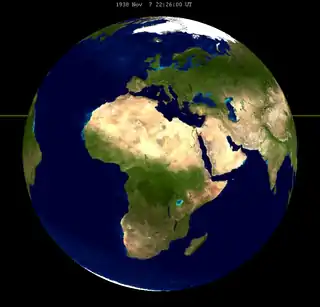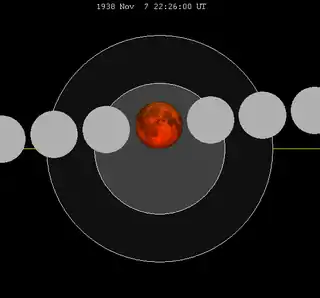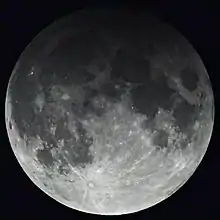October 1939 lunar eclipse
A partial lunar eclipse took place on Saturday, October 28, 1939. It was a nearly total eclipse, with 98.77% of the Moon under Earth's umbral shadow. It was the last partial lunar eclipse of the first set of partial eclipses in Saros series 135 as well as the largest partial lunar eclipse of the 20th century.

Visibility

Related lunar eclipses
| Ascending node | Descending node | |||||
|---|---|---|---|---|---|---|
| Saros | Date Viewing |
Type Chart |
Saros | Date Viewing |
Type Chart | |
| 110 | 1937 May 25 |
Penumbral |
115 | 1937 Nov 18 |
Partial | |
| 120 | 1938 May 14 |
Total |
125 | 1938 Nov 07 |
Total | |
| 130 | 1939 May 03 |
Total |
135 | 1939 Oct 28 |
Partial | |
| 140 | 1940 Apr 22 |
Penumbral |
145 | 1940 Oct 16 |
Penumbral | |
Half-Saros cycle
A lunar eclipse will be preceded and followed by solar eclipses by 9 years and 5.5 days (a half saros).[1] This lunar eclipse is related to two total solar eclipses of Solar Saros 142.
| October 21, 1930 | November 1, 1948 |
|---|---|
 |
 |
Saros series
It was part of Saros series 135.
Tritos series
- Preceded: Lunar eclipse of November 27, 1928
- Followed: Lunar eclipse of September 26, 1950
Tzolkinex
- Preceded: Lunar eclipse of September 14, 1932
- Followed: Lunar eclipse of December 8, 1946
Notes
- Mathematical Astronomy Morsels, Jean Meeus, p.110, Chapter 18, The half-saros
External links
- 1939 Oct 28 chart Eclipse Predictions by Fred Espenak, NASA/GSFC
This article is issued from Wikipedia. The text is licensed under Creative Commons - Attribution - Sharealike. Additional terms may apply for the media files.

_(cropped).jpg.webp)
